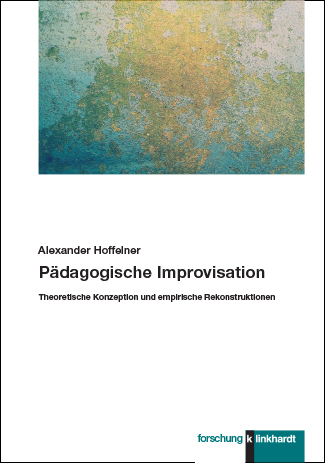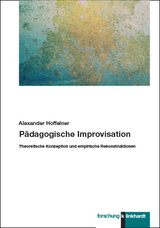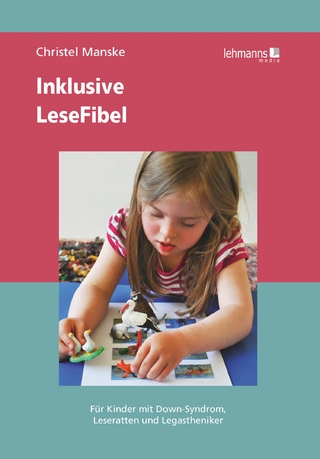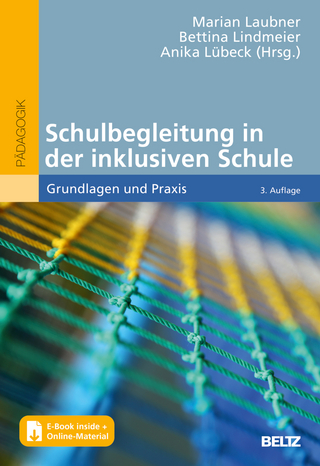Pädagogische Improvisation
Verlag Julius Klinkhardt GmbH & Co. KG
978-3-7815-2598-6 (ISBN)
Was könnte Improvisation mit Unterricht zu tun haben? Sind Lehrer:innen professionell, wenn sie improvisieren? Und wie improvisieren Lehrkräfte in ihrem Unterricht? Die vorliegende Studie untersucht das pädagogische Handeln von Lehrer:innen in der Schule unter dem Blickwinkel der Improvisation. Dazu wird das Phänomen der Improvisation im Hinblick auf bestehende handlungstheoretische und pädagogische Konzepte analysiert. Der Fokus liegt dabei u. a. auf der Professionalisierung von Lehrer:innen. Im empirischen Teil wurde das Improvisieren von Lehrer:innen aus der Sekundarstufe im Rahmen eines ethnographischen und Grounded-Theory-Ansatzes untersucht. Die Arbeit will damit einen Beitrag zum Diskurs um pädagogische Professionalität leisten.
Mag. Dr. Alexander Hoffelner, BA BA, Studien an der Universität Wien und der Swansea University (UK): Lehramtsstudium Geschichte/Politische Bildung, Geographie/ Wirtschaftskunde sowie Psychologie/Philosophie, Studium der Bildungswissenschaft (BA, Doktorat), Lehrer für gesellschaftliche und künstlerische Fächer, Hochschullehrer, Schauspieler und Theaterpädagoge.
1 Einleitung . . . . . . . . . . . . . . . . . . . . . . . . . . . . . . . . . . . . . . . . . . . . . . . . . . . . . . . . . . . . . . . . . . . . 15
1.1 Eröffnung des Problemfelds . . . . . . . . . . . . . . . . . . . . . . . . . . . . . . . . . . . . . . . . . . . . . . 16
1.2 Forschungsstand und Forschungslücke . . . . . . . . . . . . . . . . . . . . . . . . . . . . . . . . . . . . 18
1.3 Forschungsfragen . . . . . . . . . . . . . . . . . . . . . . . . . . . . . . . . . . . . . . . . . . . . . . . . . . . . . . . . 21
1.4 Struktur und Methodik der Arbeit . . . . . . . . . . . . . . . . . . . . . . . . . . . . . . . . . . . . . . . . 21
1.5 Erkenntnistheoretische Verortung . . . . . . . . . . . . . . . . . . . . . . . . . . . . . . . . . . . . . . . . . 22
Teil A: Pädagogische Improvisation | Theoretische Grundlagen
2 Methodische Vorgangsweise: Literaturanalyse und Systematisierung . . . . . . . . . . . . 29
3 Improvisation – Theoretische Grundlagen . . . . . . . . . . . . . . . . . . . . . . . . . . . . . . . . . . . . . 31
3.1 Etymologie, Bedeutung, Entwicklung:
Von der Stegreifhandlung zur Improvisation . . . . . . . . . . . . . . . . . . . . . . . . . . . . . . . 31
3.2 Arten der Improvisation . . . . . . . . . . . . . . . . . . . . . . . . . . . . . . . . . . . . . . . . . . . . . . . . . . 34
3.3 Voraussetzungen einer Improvisation . . . . . . . . . . . . . . . . . . . . . . . . . . . . . . . . . . . . . . 35
3.4 Prinzipien der Improvisation . . . . . . . . . . . . . . . . . . . . . . . . . . . . . . . . . . . . . . . . . . . . . 37
3.4.1 Ungeplantheit . . . . . . . . . . . . . . . . . . . . . . . . . . . . . . . . . . . . . . . . . . . . . . . . . . . . 37
3.4.2 Responsivität . . . . . . . . . . . . . . . . . . . . . . . . . . . . . . . . . . . . . . . . . . . . . . . . . . . . . 38
3.4.3 Unmittelbarkeit . . . . . . . . . . . . . . . . . . . . . . . . . . . . . . . . . . . . . . . . . . . . . . . . . . . 38
3.4.4 Spielerische Qualität . . . . . . . . . . . . . . . . . . . . . . . . . . . . . . . . . . . . . . . . . . . . . . 39
3.4.5 Prozesshaftigkeit . . . . . . . . . . . . . . . . . . . . . . . . . . . . . . . . . . . . . . . . . . . . . . . . . . 39
3.5 Improvisieren als menschliches Handeln – ein Zwischenfazit . . . . . . . . . . . . . . . . 40
3.6 Improvisation im Kontext der Handlungstheorie . . . . . . . . . . . . . . . . . . . . . . . . . . . 41
3.6.1 Entstehung und Entwicklung der zweckrationalen
Handlungskonzeptionen . . . . . . . . . . . . . . . . . . . . . . . . . . . . . . . . . . . . . . . . . . . 43
3.6.2 Kritik der zweckrationalen Handlungskonzeptionen . . . . . . . . . . . . . . . . . 50
3.6.3 Die Kreativität des Handelns – Improvisation im Rahmen einer
alternativen Handlungstheorie . . . . . . . . . . . . . . . . . . . . . . . . . . . . . . . . . . . . . 53
3.6.4 Handlungen als Improvisationen . . . . . . . . . . . . . . . . . . . . . . . . . . . . . . . . . . . 57
3.7 Improvisation in verschiedenen Handlungsfeldern . . . . . . . . . . . . . . . . . . . . . . . . . . 59
3.7.1 Improvisation im Theater . . . . . . . . . . . . . . . . . . . . . . . . . . . . . . . . . . . . . . . . . . 60
3.7.2 Improvisation in der Musik . . . . . . . . . . . . . . . . . . . . . . . . . . . . . . . . . . . . . . . . 65
3.7.3 Improvisation in der Rhetorik . . . . . . . . . . . . . . . . . . . . . . . . . . . . . . . . . . . . . . 67
3.7.4 Improvisation in der Management- und Organisationstheorie . . . . . . . . . 67
3.7.5 Improvisation in der Medizin . . . . . . . . . . . . . . . . . . . . . . . . . . . . . . . . . . . . . . 69
3.7.6 Improvisation in der empirischen Sozialforschung . . . . . . . . . . . . . . . . . . . . 69
4 Pädagogische Professionalität . . . . . . . . . . . . . . . . . . . . . . . . . . . . . . . . . . . . . . . . . . . . . . . . . 73
4.1 Begriffliche Grundlegungen . . . . . . . . . . . . . . . . . . . . . . . . . . . . . . . . . . . . . . . . . . . . . . 73
4.1.1 Professionen . . . . . . . . . . . . . . . . . . . . . . . . . . . . . . . . . . . . . . . . . . . . . . . . . . . . . . 74
4.1.2 Aspekte pädagogischen Handelns im Rahmen der
Lehrer:innenprofession . . . . . . . . . . . . . . . . . . . . . . . . . . . . . . . . . . . . . . . . . . . . 75
4.2 Ansätze pädagogischer Professionalität . . . . . . . . . . . . . . . . . . . . . . . . . . . . . . . . . . . . 79
4.2.1 Kompetenzorientiere Ansätze . . . . . . . . . . . . . . . . . . . . . . . . . . . . . . . . . . . . . . 79
4.2.2 Strukturtheoretischer Ansatz . . . . . . . . . . . . . . . . . . . . . . . . . . . . . . . . . . . . . . . 95
4.2.3 Kompetenzorientierte und strukturtheoretische Ansätze
pädagogischer Professionalität und Improvisation – ein Fazit . . . . . . . . . . 103
4.2.4 EPIK-Domänenmodell . . . . . . . . . . . . . . . . . . . . . . . . . . . . . . . . . . . . . . . . . . . . 104
4.3 Ungewissheit im pädagogischen Handeln . . . . . . . . . . . . . . . . . . . . . . . . . . . . . . . . . . 107
4.3.1 Ungewissheit im Lehrer:innenhandeln in der Literatur für
Lehrer:innen . . . . . . . . . . . . . . . . . . . . . . . . . . . . . . . . . . . . . . . . . . . . . . . . . . . . . . 108
4.3.2 Technologiedefizit . . . . . . . . . . . . . . . . . . . . . . . . . . . . . . . . . . . . . . . . . . . . . . . . 110
4.3.3 Felder der Ungewissheit . . . . . . . . . . . . . . . . . . . . . . . . . . . . . . . . . . . . . . . . . . . 113
4.3.4 Umgang mit Ungewissheit . . . . . . . . . . . . . . . . . . . . . . . . . . . . . . . . . . . . . . . . . 116
5 Pädagogische Improvisation . . . . . . . . . . . . . . . . . . . . . . . . . . . . . . . . . . . . . . . . . . . . . . . . . . . 120
5.1 Improvisation als methodische Herangehensweise im Unterricht . . . . . . . . . . . . 121
5.2 Teaching as Performance: Lehrer:innen als Schauspieler:innen . . . . . . . . . . . . . . 125
5.2.1 Unterrichten als Kunst . . . . . . . . . . . . . . . . . . . . . . . . . . . . . . . . . . . . . . . . . . . . . 128
5.2.2 Lehrer:innen und ihre Rolle . . . . . . . . . . . . . . . . . . . . . . . . . . . . . . . . . . . . . . . . 130
5.2.3 Die Lehrperson als Schauspieler:in . . . . . . . . . . . . . . . . . . . . . . . . . . . . . . . . . . 140
5.2.4 Die Lehrperson als Improvisateur:in . . . . . . . . . . . . . . . . . . . . . . . . . . . . . . . . 146
5.3 Ansätze und Konzepte pädagogischer Improvisation . . . . . . . . . . . . . . . . . . . . . . . . 150
5.3.1 Gelegenheitsunterricht als Möglichkeit zur Improvisation . . . . . . . . . . . . 151
5.3.2 Erziehung als reflektierte Improvisation . . . . . . . . . . . . . . . . . . . . . . . . . . . . . 154
5.3.3 Guided Improvisation . . . . . . . . . . . . . . . . . . . . . . . . . . . . . . . . . . . . . . . . . . . . . 162
5.3.4 Improvisation in Teaching and Education . . . . . . . . . . . . . . . . . . . . . . . . . . . 177
5.3.5 Ansätze und Konzepte pädagogischer Improvisation – ein Fazit . . . . . . . 185
Teil B: Pädagogische Improvisation | Empirische Rekonstruktionen
6 Methodische Grundlagen und Vorgangsweise . . . . . . . . . . . . . . . . . . . . . . . . . . . . . . . . . . 189
6.1 Datenerhebung im Rahmen des ethnographischen Zugangs . . . . . . . . . . . . . . . . . 189
6.2 Dateninterpretation im Rahmen der Grounded Theory Methodology . . . . . . . . 196
6.3 Ethnographischer Zugang und Grounded Theory – eine Resümee . . . . . . . . . . . 200
6.4 Sampling . . . . . . . . . . . . . . . . . . . . . . . . . . . . . . . . . . . . . . . . . . . . . . . . . . . . . . . . . . . . . . . 201
6.5 Gütekriterien der Forschung . . . . . . . . . . . . . . . . . . . . . . . . . . . . . . . . . . . . . . . . . . . . . . 204
6.6 Reflexion der eigenen Position im Feld . . . . . . . . . . . . . . . . . . . . . . . . . . . . . . . . . . . . 205
7 Improvisierende Lehrer:innen . . . . . . . . . . . . . . . . . . . . . . . . . . . . . . . . . . . . . . . . . . . . . . . . . 209
7.1 Lehrer:innen . . . . . . . . . . . . . . . . . . . . . . . . . . . . . . . . . . . . . . . . . . . . . . . . . . . . . . . . . . . . 209
7.2 Improvisationsverständnis der Lehrer:innen . . . . . . . . . . . . . . . . . . . . . . . . . . . . . . . 210
7.2.1 Caro Krüger: Improvisieren als Loslassen . . . . . . . . . . . . . . . . . . . . . . . . . . . . 210
7.2.2 Frederik Lakoon: Zwischen Theorie und Unsicherheit . . . . . . . . . . . . . . . . 217
7.2.3 Fabian Schneider: Zwischen Schema F und Schwellenpädagogik . . . . . . 227
7.2.4 Maria Stein: Improvisieren als Rückgriff auf ein Repertoire . . . . . . . . . . . 232
7.2.5 Sarah Veit: Sich trauen zu improvisieren . . . . . . . . . . . . . . . . . . . . . . . . . . . . . 239
7.2.6 Das Improvisationsverständnis der Lehrer:innen im kontrastierenden
Vergleich . . . . . . . . . . . . . . . . . . . . . . . . . . . . . . . . . . . . . . . . . . . . . . . . . . . . . . . . . 245
7.3 Improvisieren in konkreten Unterrichtssituationen . . . . . . . . . . . . . . . . . . . . . . . . . 268
7.3.1 Die Eindringlinge von außen . . . . . . . . . . . . . . . . . . . . . . . . . . . . . . . . . . . . . . . 269
7.3.2 Das fehlende Arbeitsmaterial . . . . . . . . . . . . . . . . . . . . . . . . . . . . . . . . . . . . . . . 275
7.3.3 Den Arbeitsmodus klären . . . . . . . . . . . . . . . . . . . . . . . . . . . . . . . . . . . . . . . . . . 279
7.3.4 Die Disziplin herstellen . . . . . . . . . . . . . . . . . . . . . . . . . . . . . . . . . . . . . . . . . . . . 282
7.3.5 Die Klasse als Bühne . . . . . . . . . . . . . . . . . . . . . . . . . . . . . . . . . . . . . . . . . . . . . . . 287
7.3.6 Die Improvisation dokumentieren . . . . . . . . . . . . . . . . . . . . . . . . . . . . . . . . . . 295
8 Fazit und Diskussion . . . . . . . . . . . . . . . . . . . . . . . . . . . . . . . . . . . . . . . . . . . . . . . . . . . . . . . . . . 302
Verzeichnisse . . . . . . . . . . . . . . . . . . . . . . . . . . . . . . . . . . . . . . . . . . . . . . . . . . . . . . . . . . . . . . . . . . . . . 311
Literaturverzeichnis . . . . . . . . . . . . . . . . . . . . . . . . . . . . . . . . . . . . . . . . . . . . . . . . . . . . . . . . . . . . . . . 311
Abbildungsverzeichnis . . . . . . . . . . . . . . . . . . . . . . . . . . . . . . . . . . . . . . . . . . . . . . . . . . . . . . . . . . . . . 334
Danksagung . . . . . . . . . . . . . . . . . . . . . . . . . . . . . . . . . . . . . . . . . . . . . . . . . . . . . . . . . . . . . . . . . . . . . . 335
| Erscheinungsdatum | 20.10.2023 |
|---|---|
| Reihe/Serie | klinkhardt forschung |
| Verlagsort | Bad Heilbrunn |
| Sprache | deutsch |
| Maße | 165 x 235 mm |
| Themenwelt | Sozialwissenschaften ► Pädagogik ► Schulpädagogik / Grundschule |
| Schlagworte | Lehrerausbildung • Lehrerbildung • Lehrerfortbildung • Lehrerhandeln • Motivationsforschung • Pädagogische Professionalität • professionsentwicklung • Professionsforschung • Unterrichtsforschung • Unterrichtsplanung |
| ISBN-10 | 3-7815-2598-8 / 3781525988 |
| ISBN-13 | 978-3-7815-2598-6 / 9783781525986 |
| Zustand | Neuware |
| Haben Sie eine Frage zum Produkt? |
aus dem Bereich




